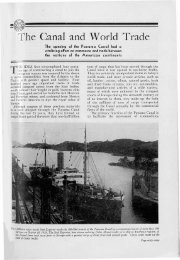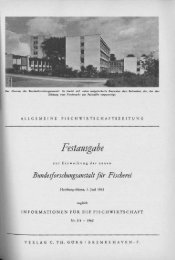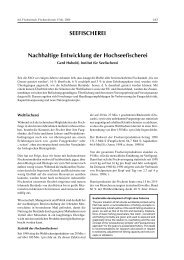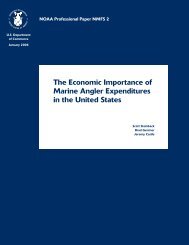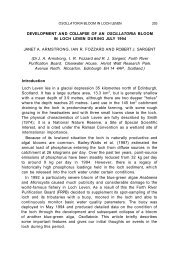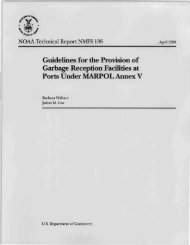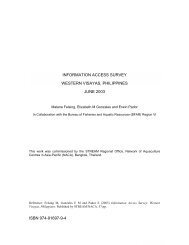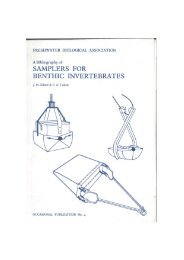Obituary: Gerard Corley Smith - Aquatic Commons
Obituary: Gerard Corley Smith - Aquatic Commons
Obituary: Gerard Corley Smith - Aquatic Commons
You also want an ePaper? Increase the reach of your titles
YUMPU automatically turns print PDFs into web optimized ePapers that Google loves.
April1998 NOTICIAS DE GALÁP AGOS 35<br />
A SANTA CRUZ PIONEER HAS DIED<br />
On February 19, 1997, Mrs. Elfriede Horneman passed<br />
away in the home of her daughter, Mrs. Friedel Vonka,<br />
near Kirkenes, in the north of Norway, where she had<br />
been living for a number of years. She would have been<br />
ninety years old in October.<br />
Born in Frankfort as Elfriede Engelmann, she learned<br />
to speak severallanguages and worked as a secretary,<br />
until she met Jacob Hersleb Horneman, a Norwegian<br />
mining engineer, in England in 1938. The two married<br />
and went to Galápagos, where Horneman had owned<br />
property in the Santa Cruz highlands since 1927.<br />
The slender city girl soon became a tough, hard-working<br />
Galápagos pioneer, adapting to the primitive<br />
conditions and making the best of what the island had to<br />
offer. One of her first actions was to change the name of<br />
the Horneman property from "Progreso" to the more<br />
realistic "Vilnis," Norwegian for "wilderness," then laboring<br />
hard to keep the place from living up to its new<br />
name.<br />
Though she began suffering from back problems,<br />
which caused her considerable pain, Mrs. Horneman<br />
continued working, even learning to lay bricks and wield<br />
the machete. However, she always kept a bright smile<br />
and a brave optimism, no matter how bad things could<br />
seem. Thus, she raised two children, a daughter and a<br />
son, and kept things going.<br />
As if this were not enough, she also offered hearty<br />
hospitality to every visitor, and many well known people<br />
found a welcome in her home: Thor Heyerdahl, Robert<br />
Bowman, Eric Shipton, Sven Gilsater of Swedish TV, E.<br />
Yale Dawson, and many others. However, her hospitality<br />
was offered with equal generosity to the poor and<br />
unknown visitor or to fellow settlers who happened to<br />
come to the Horneman home. As the years went by, she<br />
gradually beca me known as "Mutti" to many of these<br />
friends.<br />
Mrs. Horneman finished translating Dr. Stein Hoff's<br />
excellent history on the Norwegian settlers in the<br />
Galápagos, Dremmen om Galápagos (The Dream about<br />
Galápagos), from the Norwegian original to English.<br />
Unfortunately, she died before seeing this work in print.<br />
Those of us who were fortunate enough to know her<br />
feel her death as a great personal 1055.<br />
J. P. Lundh.<br />
GERARD CORLEY SMITH<br />
<strong>Gerard</strong> <strong>Corley</strong> <strong>Smith</strong>,<br />
CMG, former Ambassador to Ecuador,<br />
died on October 7 aged 88. He was born on<br />
July 30, 1909.<br />
AIthough he had a long and distinguished career in<br />
the diplomatic service, <strong>Gerard</strong> <strong>Corley</strong> <strong>Smith</strong> will be particularly<br />
remembered for his close involvement with the<br />
cause of conservation in the Galapagos Islands. His association<br />
with the islands began in 1962, when as<br />
Ambassador to Ecuador he attended the official opening<br />
of the Charles Darwin Research Station, and gained an<br />
insight into the unique wonders of that archipelago and<br />
the strenuous efforts being made to safeguard them for<br />
the future. It was a cause that he was to espouse for the<br />
rest of his life.<br />
<strong>Gerard</strong> Thomas <strong>Corley</strong> <strong>Smith</strong> was educated at BoIton<br />
School and Emmanuel College, Cambridge. In 1931 he<br />
entered the General Consular Service, and over the next<br />
15 years he served in Paris, Oran, Detroit, La Paz, Milan,<br />
St Louis and Brussels. He first carne to international attention<br />
in 1949 when, as the British representative on the<br />
UN Economic and Social Council in New York, he was<br />
chosen to present the case against the Soviet forced labour<br />
camps, or gulags, the existence of which was only then<br />
beginning to be revealed to the world. It was a task that<br />
predictably earned him the anger and disapproval of the<br />
Eastern bloc delegations and their press.<br />
<strong>Corley</strong> <strong>Smith</strong> returned to Europe in 1952, and in the<br />
same year was appointed CMG. His next posting was to<br />
Paris, where he served for two years as press counsellor<br />
at the British Embassy. From there he went to Madrid to<br />
take up the appointment as labour counsellor at the British<br />
Embassy, 1954-59.<br />
With his wide experience, <strong>Corley</strong> <strong>Smith</strong> became Ambassador<br />
to Haiti in 1960. It was not an easy posting, nor<br />
could it have been under the harrowing and deeply oppressive<br />
regime ofFran
36 NOTICIAS DE GALÁP AGOS No. 59<br />
But the misrule there, the mis trust he saw, and the "atmosphere<br />
of brooding terror" became increasingly hard to<br />
bear.<br />
Once again, <strong>Corley</strong> <strong>Smith</strong> was chosen as spokesman,<br />
this time for a delegation of ambassadors protesting<br />
against the extortion being practised on foreigners by the<br />
Tontons Macoute, Duvalier's infamous bogeymen and<br />
secret police. When he was asked by the Haitian Minister<br />
for Foreign Affairs who was doing the extortion, <strong>Corley</strong><br />
<strong>Smith</strong> replied "the Tontons Macoute." "Who are they? 1<br />
never heard of them," objected the Minister, himself a<br />
Macoute. When <strong>Corley</strong> <strong>Smith</strong> said he need only ask the<br />
first person he met on the street, he was given 48 hours to<br />
leave the country, on Duvalier's order. The beleaguered<br />
regime added: "The Haitian Government has made it<br />
known to this famous ambassador . . . that his impertinence<br />
and haughtiness as a British colonialist would not<br />
be tolerated."<br />
<strong>Corley</strong> <strong>Smith</strong>' s next appointment was to Ecuador in<br />
1962. In Quito he found an altogether more con genial<br />
atmosphere, and unlimited scope in the country around<br />
him to pursue his interest in ornithology. Staff at the<br />
embassy soon took it as a matter of course that his official<br />
duties would be interspersed with bird-watching trips to<br />
the Andes.<br />
An interest in high-altitude hummingbirds brought<br />
him into contact with Professor Jean Dorst of the French<br />
National Museum ofNatural History in Paris, an authority<br />
on these birds who was also President of the Charles<br />
Darwin Foundation for the Galapagos Islands.<br />
A second journey to Galapagos followed in 1964, when<br />
<strong>Corley</strong> <strong>Smith</strong> joined the Duke of Edinburgh during his<br />
first visit to the archipelago on the Royal Yacht Britannia.<br />
It was a visit that had repercussions for both men. The<br />
Duke would la ter become patron of the Charles Darwin<br />
Foundation; the ambassador "became hooked on<br />
Galapagos."<br />
Throughout his remaining time in Ecuador, <strong>Corley</strong><br />
<strong>Smith</strong> took a discreet but influential part in Galapagos<br />
affairs, embracing the idea that wildlife-orientated tourism<br />
could be the key to economic stability for the islands,<br />
and helping to engineer the Grimwood-Snow Mission<br />
and Report, which gave recommendations for the administration<br />
for the future national park.<br />
<strong>Corley</strong> <strong>Smith</strong> left Ecuador in 1967, and the following<br />
year the new National Parks Service of Ecuador carne into<br />
existence. The newly retired ambassador was lured to<br />
join the executive council of the Charles Darwin Foundation.<br />
The first meeting he attended was in England, at<br />
Down House, Darwin's former home, where members<br />
saw in the tall, silver-haired and distinguished-Iooking<br />
former diploma t a remar kable likeness to the portrai t there<br />
ofT. H. Huxley. In 1972, w hen Sir Thomas Barlow stepped<br />
down, <strong>Corley</strong> <strong>Smith</strong> took on the role of secretary-general<br />
of the foundation. It was a great coup for the ever-persuasive<br />
Dorst.<br />
Over the next ten years <strong>Corley</strong> <strong>Smith</strong> served the foundation<br />
diligently and wholeheartedly. Those who worked<br />
with him during that period cherish the memory of his<br />
quiet skill in handling complex problems, his sage advice,<br />
and the bravado with which he ran the show "from an<br />
attic bedroom, with one typist paid (and badly) by the<br />
hour." In addition, he edited, published and distributed<br />
24 "well-nourished" issues of the foundation' s bulletin<br />
Noticias de Galápagos.<br />
It was a buoyant period in Galapagos affairs. With his<br />
natural optimism and his gratitude to successive<br />
Ecuadorean administrations for their commitment to international<br />
science, <strong>Corley</strong> <strong>Smith</strong> helped to forge the<br />
remarkable alliance that grew between the national Government<br />
and this voluntary organisation. "Most<br />
crucially," as Dorst later wrote, "he perceived and understood<br />
the way the foundation had to meet and adapt to<br />
changing conditions in Ecuador."<br />
On his retirement from the post of secretary-general,<br />
<strong>Corley</strong> <strong>Smith</strong> was awarded the Order "Al Mérito" by the<br />
Government of Ecuador for his services to science and<br />
conservation in the Galapagos Islands.<br />
<strong>Corley</strong> <strong>Smith</strong> married Joan Haggard in 1937. She predeceased<br />
him, but he is survived by a son and three<br />
daughters.<br />
Reprinted with permission of The Times, London. @ The<br />
Times, London, 3rd November 1997.<br />
CDRS file photo



